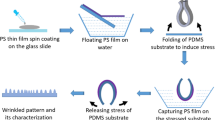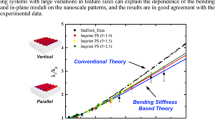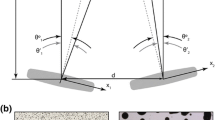Abstract
Stereo digital image correlation (StereoDIC) measurements of wrinkle shapes and surface deformations along with numerical simulation results of prepreg tapes steered along paths having different radii of curvature without adhesion to a Teflon-coated substrate are presented. Experiments are conducted at temperatures ranging from 25 to 350 °C on thermoplastic prepreg tape (APC-2/AS4) having various widths. For the baseline studies at room temperature (25 °C), finite element simulation results from the combined experimental-computational study show very good agreement for both the wrinkling mode shape and general trends in the surface strains. Measurements do indicate a sharp change in the longitudinal and transverse strains for the two smallest steering radii, indicating the development of mesoscale damage in the prepreg. Finally, results from the experiments confirm that there is no significant deviation in the deformation response of the prepreg tape when performing steering at temperatures from 25 to 110 °C. However, significant differences in the deformation pattern of the thermoplastic tape are observed above the glass transition temperature, Tg, of the matrix material.


















Similar content being viewed by others
Notes
Many previous investigators have used FEA along with full-field data to improve their understanding of specimen response, such as shown in [27] for the vibrational response of a structure.
An estimate for the accuracy of the strain measurements using StereoDIC is obtained by performing image correlation of multiple speckle images taken in the reference configuration. Results confirm that the standard deviation in the strain measurements for the parameters noted above is ~ 150 με.
The investigators obtained 120 image pairs during calibration so that any imperfect images (e.g. blurred) images could be discarded. Only 50 image pairs (5400 data points) were used in the analysis to obtain less than 30 parameters for the stereovision system [29]. This gives more than 200 equations per parameter, providing confidence in the resulting mean parameter values.
Once the specimen reaches the required temperatures in the range 150 to 350 °C, comparison of the images acquired over the 30s time frame indicates that no significant additional creep was observed. Additional insight into the characteristic time for the thermoplastic prepreg tape specimens could be obtained through dynamic mechanical analysis experiments, which will be the subject of our future research.
Since a step size of 1 pixel provides more data points close to the boundary, extrapolation of the data was performed using experimental data obtained with a step size of 1 pixel. However, the difference between the extrapolated boundary value of displacement using data obtained with a step size of 1 pixel and 7 pixels was small, on the order of 0.5%.
FE analysis was performed using the as-measured displacements and rotations. The discrepancy noted above is highlighted to emphasize that StereoDIC provides a direct way to quantify displacement boundary conditions.
Modeling of the tape for temperatures above Tg requires viscoelastic properties of the tape material. Measurement of viscoelastic properties and the associated finite element modeling of the tape above Tg will be the subject of a future publication.
With regard to the highly localized changes in strain shown in Figs. 15, 16 and 17, the authors confirmed that these trends are not due to DIC processing parameters such as subset size, subset spacing or strain filter size. The high local gradients shown in Figs. 16 and 17 near the centerline are re-checked using a range of subset sizes, subset spacing and strain filters. In all cases, the steep gradients and rapid changes remained, though they slightly changed in magnitude and width. The local higher strain is also observed in approximately the same locations in a repeat test with a different speckle pattern size and viewing angle. Also, the local steep gradients of the strain are not visible for the higher radii of curvatures. Thus, the high gradients in strain are indicative of changes in material behavior rather than an artifact in the DIC measurement.
These localized damage processes may be visible in an SEM or a high-resolution CT scan, but neither were performed during this study. Measurement and modeling of the evolution of such defects and their effect on the macroscale deformation patterns very well could be the subject of further research.
References
Crosky A, Grant C, Kelly D et al (2015) 4 – Fibre placement processes for composites manufacture. In: Adv. Compos. Manuf. Process des, pp 79–92
Qureshi Z, Swait T, Scaife R, El-Dessouky HM (2014) In situ consolidation of thermoplastic prepreg tape using automated tape placement technology: potential and possibilities. Compos Part B 66:255–267. https://doi.org/10.1016/j.compositesb.2014.05.025
Gürdal Z, Tatting BF, Wu CK (2008) Variable stiffness composite panels: effects of stiffness variation on the in-plane and buckling response. Compos A: Appl Sci Manuf 39:911–922. https://doi.org/10.1016/j.compositesa.2007.11.015
Gürdal Z, Olmedo R (1993) In-plane response of laminates with spatially varying fiber orientations - variable stiffness concept. AIAA J 31:751–758. https://doi.org/10.2514/3.11613
Lopes CS, Gürdal ZZ, Camanho PP (2008) Variable-stiffness composite panels: buckling and first-ply failure improvements over straight-fibre laminates. Comput Struct 86:897–907. https://doi.org/10.1016/j.compstruc.2007.04.016
Chen X, Wu Z, Nie G, Weaver P (2018) Buckling analysis of variable angle tow composite plates with a through-the-width or an embedded rectangular delamination. Int J Solids Struct 138:166–180. https://doi.org/10.1016/J.IJSOLSTR.2018.01.010
Wu Z, Raju G, Weaver PM (2018) Optimization of postbuckling behaviour of variable thickness composite panels with variable angle tows: towards “buckle-free” design concept. Int J Solids Struct 132–133:66–79. https://doi.org/10.1016/J.IJSOLSTR.2017.08.037
Raju G, Wu Z, Weaver PM (2013) Postbuckling analysis of variable angle tow plates using differential quadrature method. Compos Struct 106:74–84. https://doi.org/10.1016/j.compstruct.2013.05.010
Long AC, Clifford MJ (2007) Composite forming mechanisms and materials characterisation. Compos Form Technol 1–21. https://doi.org/10.1533/9781845692537.1
Liang B, Hamila N, Peillon M, Boisse P (2014) Analysis of thermoplastic prepreg bending stiffness during manufacturing and of its influence on wrinkling simulations. Compos A: Appl Sci Manuf 67:111–122. https://doi.org/10.1016/J.COMPOSITESA.2014.08.020
Kim BC, Potter K, Weaver PM (2012) Continuous tow shearing for manufacturing variable angle tow composites. Compos Part A 43:1347–1356. https://doi.org/10.1016/j.compositesa.2012.02.024
Ouagne P, Soulat D, Tephany C, Gillibert J (2016) Measurement of the appearance and growth of tow buckling defect in the frame of complex shape manufacturing process by using fringe projection technique. Strain 52:559–569. https://doi.org/10.1111/str.12206
Boisse P, Hamila N, Madeo A (2016) Modelling the development of defects during composite reinforcements and prepreg forming. Philos Trans R Soc A Math Phys Eng Sci 374:20150269. https://doi.org/10.1098/rsta.2015.0269
Skordos AA, Monroy Aceves C, Sutcliffe MPF (2007) A simplified rate dependent model of forming and wrinkling of pre-impregnated woven composites. Compos A: Appl Sci Manuf 38:1318–1330. https://doi.org/10.1016/J.COMPOSITESA.2006.11.005
Sargent J, Chen J, Sherwood J et al (2010) Benchmark study of finite element models for simulating the Thermostamping of woven-fabric reinforced composites. Int J Mater Form 3:683–686. https://doi.org/10.1007/s12289-010-0862-5
Sherwood J, Fetfatsidis K, Winchester D et al (2010) Using modal analysis to investigate the validity of finite element models for simulating the Thermostamping of woven-fabric reinforced composites. Int J Mater Form 3:687–690. https://doi.org/10.1007/s12289-010-0863-4
Jauffrès D, Morris CD, Sherwood JA, Chen J (2009) Simulation of the thermostamping of woven composites: determination of the tensile and in-plane shearing behaviors. Int J Mater Form 2:161–164. https://doi.org/10.1007/s12289-009-0590-x
Guzman-Maldonado E, Hamila N, Boisse P, Bikard J (2015) Thermomechanical analysis, modelling and simulation of the forming of pre-impregnated thermoplastics composites. Compos A: Appl Sci Manuf 78:211–222. https://doi.org/10.1016/J.COMPOSITESA.2015.08.017
de Luca P, Lefébure P, Pickett AK (1998) Numerical and experimental investigation of some press forming parameters of two fibre reinforced thermoplastics: APC2-AS4 and PEI-CETEX. Compos A: Appl Sci Manuf 29:101–110. https://doi.org/10.1016/S1359-835X(97)00060-2
Sharma SB, Sutcliffe MPF (2004) A simplified finite element model for draping of woven material. Compos A: Appl Sci Manuf 35:637–643. https://doi.org/10.1016/J.COMPOSITESA.2004.02.013
Boisse P, Colmars J, Hamila N et al (2018) Bending and wrinkling of composite fiber preforms and prepregs. A review and new developments in the draping simulations. Compos Part B 141:234–249. https://doi.org/10.1016/J.COMPOSITESB.2017.12.061
Sutton MA, McNeill SR, Helm JD, Chao YJ (2000) Advances in two-dimensional and three-dimensional computer vision. In: Photomechanics. Springer Berlin Heidelberg, Berlin, pp 323–372
Sutton MA (2013) Computer vision-based, noncontacting deformation measurements in mechanics: a generational transformation. Appl Mech Rev 65:050000. https://doi.org/10.1115/1.4024984
Sutton MA, Matta F, Rizos D et al (2017) Recent Progress in digital image correlation: background and developments since the 2013 W M Murray lecture. Exp Mech. https://doi.org/10.1007/s11340-016-0233-3
Luo PF, Chao YJ, Sutton MA, Peters WH (1993) Accurate measurement of three-dimensional deformations in deformable and rigid bodies using computer vision. Exp Mech 33:123–132. https://doi.org/10.1007/BF02322488
Sutton MA, Orteu J-J, Schreier H (2009) Image correlation for shape, motion and deformation measurements. Springer. https://doi.org/10.1007/978-0-387-78747-3
Wang W, Mottershead JE, Ihle A et al (2011) Finite element model updating from full-field vibration measurement using digital image correlation. J Sound Vib 330:1599–1620. https://doi.org/10.1016/j.jsv.2010.10.036
Correlated Solutions. http://correlatedsolutions.com/. Accessed 14 June 2017
Reu P (2013) A study of the influence of calibration uncertainty on the global uncertainty for digital image correlation using a Monte Carlo approach. Exp Mech 53(9):1661–1680. https://doi.org/10.1007/s11340-013-9746-1
TenCate Cetex® TC1200 - TenCate Advanced Composites. https://www.tencatecomposites.com/product-explorer/products/ovl4/TenCate-Cetex-TC1200. Accessed 13 Apr 2018
Abaqus 6.14 Documentation. http://abaqus.software.polimi.it/v6.14/index.html. Accessed 14 June 2018
Rajan S, Sutton MA, Fuerte R, Kidane A (2018) Traction-separation relationship for polymer-modified bitumen under mode I loading: double cantilever beam experiment with stereo digital image correlation. Eng Fract Mech. https://doi.org/10.1016/j.engfracmech.2017.12.031
Acknowledgements
Funding provided by Boeing Research Contract SSOWBRTW0915000 and associated matching funds provided by University of South Carolina Vice President for Finance Edward Walton via 15540 E250 is deeply appreciated. All materials and access to the Ingersoll AFP facility provided by the McNair Aerospace Center, University of South Carolina is gratefully acknowledged. The technical support and assistance of the McNair technical staff, particularly Mr. Burton Rhodes, Jr. and Prof. Ramy Harik during operation of the AFP, is also greatly appreciated. Finally, the support of Ms. Eileen Miller, Boeing Research and Technology in Charleston, SC, is gratefully acknowledged.
Author information
Authors and Affiliations
Corresponding author
Additional information
Publisher’s Note
Springer Nature remains neutral with regard to jurisdictional claims in published maps and institutional affiliations.
Appendix
Appendix
LEFT: StereoDIC measurement of out-of-plane displacement for (a) 9.5 mm and (b) 15.8 mm wide prepreg tape at 25 °C for a steering radius of 305 mm. RIGHT: Corresponding FE simulation results. (For interpretation of the references to color in this figure legend, the reader is referred to the web version of this article)
LEFT: StereoDIC measurement of longitudinal strain map for (a) 9.5 mm and (b) 15.8 mm wide prepreg tape at 25 °C for a steering radius of 305 mm. RIGHT: Corresponding FE simulation results. (For interpretation of the references to color in this figure legend, the reader is referred to the web version of this article)
LEFT: StereoDIC measurement of transverse strain map for (a) 9.5 mm and (b) 15.8 mm wide prepreg tape at 25 °C for a steering radius of 305 mm. RIGHT: Corresponding FE simulation results. (For interpretation of the references to color in this figure legend, the reader is referred to the web version of this article)
LEFT: StereoDIC measurement of in plane shear strain map for (a) 9.5 mm and (b) 15.8 mm wide prepreg tape at 25 °C for a steering radius of 305 mm. RIGHT: Corresponding FE simulation results. (For interpretation of the references to color in this figure legend, the reader is referred to the web version of this article)
Rights and permissions
About this article
Cite this article
Rajan, S., Sutton, M., Wehbe, R. et al. Measured Surface Deformation and Strains in Thin Thermoplastic Prepreg Tapes Steered along Curved Paths without Adhesion Using StereoDIC. Exp Mech 59, 531–547 (2019). https://doi.org/10.1007/s11340-019-00478-3
Received:
Accepted:
Published:
Issue Date:
DOI: https://doi.org/10.1007/s11340-019-00478-3








